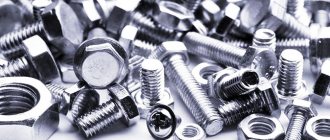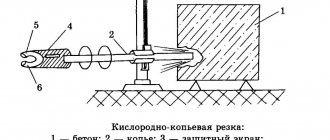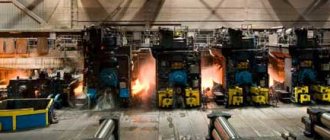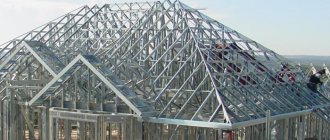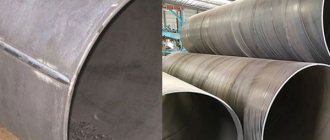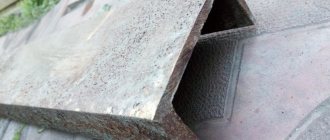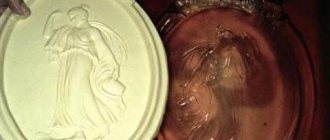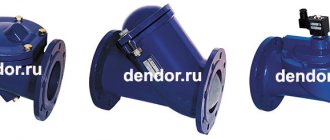Modern industry produces a wide variety of aluminum profile structures that are used in various fields of activity. A popular rolled metal product is aluminum angle , which, thanks to its quality characteristics, has proven itself not only in construction, but also in other high-tech areas of production.
- Features of the production of aluminum corners
- Characteristics
- Operational benefits
Aluminum corner - types and classification
A corner is an L-shaped product that is made of aluminum or its alloys. The width of the sides (shelves) of this profile can be the same (equal) or different (unequal). Depending on the production technology, the corners of the base and edges of the shelves can be straight or rounded. A corner is obtained by bending a sheet of aluminum blank at a right angle using special equipment. Properties depend on the chemical composition and production method.
The following grades of aluminum and its alloys are used for manufacturing:
- AD, A0, AMg, AMts, AD31, D16 – for the production of general purpose profiles;
- AD00, AD0, A7, A5E, AD31E, AD31 – for electrical corners.
For an equal-flange profile, the width of the flanges varies in the range of 10–200 mm, and the thickness is 1–43 mm. For an unequal angle, these indicators are in the range of 6–265 mm and 1–66 mm, respectively. Angles, based on the condition of the material, are divided into non-heat-treated, soft (annealed) and hardened.
Based on the nature of processing, they are distinguished:
- not processed;
- coated with paints and varnishes (Zhl);
- coated by electrophoresis with a liquid substance (Zhe);
- anodized – subjected to electrolytic treatment (An);
- coated with a polymer powder substance (P);
- coated with a complex two-layer substance (K).
The marking of an aluminum corner indicates the width of the shelves in mm (for example, 50x50 for an equal shelf). The thickness may also be indicated - for example, 50x30x2, where the last number is the thickness in mm, and the corner is unequal. The corner profile is supplied in sections of multiple measured, unmeasured and measured lengths.
In addition to the solid corner of the correct profile, they also produce perforated and profiled products. The first option is structurally an ordinary corner, but with perforation - holes in the shelves. The second, made in an L-shape, has folds (grooves) on the edges of the shelves and (or) at the bend, the shape of which is determined by the functional purpose of the corner profile.
This is interesting: Stainless steel pipe: GOST, characteristics, application
Varieties
Corners are divided into internal and external; according to this, two types of trims are produced.
Interior
The cross section of the profile resembles the letter “G”, to the short crossbar of which a front part in the form of a gutter is attached. The long part of the letter "G" represents the base. Between it and the gutter there is a groove for the tiles.
Trims of this type are not always installed, since it is quite possible to do without them. The inner corner does not protrude like the outer corner and is not as noticeable. In addition, these elements are more expensive than external ones. But still, the cladding with them looks much more interesting.
Corner option
Outer
The cross section of the profile resembles the Latin letter “V”. One part of the “bird” is the base, the second is the front part, and the gap between them acts as a groove for the tile.
This is a much more popular option. The outer corner is visible and, being sharp, poses a danger. Therefore, installing trim in this location is especially necessary.
Internal corners are divided into two types:
- vertical;
- horizontal.
Tiled corner
Classification
Angles made of aluminum, the range of which is determined by the requirements of the relevant regulatory document, are widely used:
- for the manufacture of structures that must simultaneously be characterized by high strength and low weight;
- in the production of sea and river vessels;
- in the automotive industry;
- for the construction of enclosing structures, which, in addition to strength and stability, must have good decorative characteristics.
Aluminum corner is popular among pickup truck owners who use this lightweight and reliable material for their homemade structures.
Due to the ease of processing, corner aluminum profiles are used to produce supports for various purposes, brackets, as well as other structural elements that must be light and at the same time durable. It is also convenient that the strength of products made from such corners can be increased if they are subjected to heat treatment. The resistance of such structures to aggressive environments can be significantly increased using a technological operation such as anodizing.
Aluminum corners, depending on the scope of application, production technology and main characteristics, are divided into the following categories.
Equal
These are corner aluminum profiles, differing in the same width of the shelves. Such corners are used for the manufacture of lightweight structures, in the production of furniture, as a lining material, and also for solving many other problems.
Unequal
A distinctive feature of such products is that they are able to maintain their profile when bending. For this reason, such aluminum profiles are ideal for the manufacture of structures with complex geometric shapes.
Profiled
These products are used primarily as connecting elements of structures for various purposes.
Perforated
Corners with perforated shelves are used for cladding various types of surfaces. The corners of structures lined with such profiles are not only distinguished by their correct geometric shape, but are also reliably protected from mechanical damage.
Anodized
Due to the special coating formed on their surface, such aluminum products are characterized by high corrosion resistance, exceptional durability, and electrical insulating properties. Corners of this type are used to create structures that will be used outdoors, under aggressive environmental influences.
Decorative
These are corners that have an attractive appearance. They are actively used in the production of furniture and furniture fittings, other interior items, for fastening shelves, mirrors and glass, and for solving other decorative problems.
Aluminum corner for finishing thresholds and steps of stairs
Benefits of use
Aluminum is a more ductile material than steel, so it is much easier to manufacture products with a specific cross-sectional profile from it. Corners made from this material have the following characteristics:
- exceptionally high resistance to corrosion (hence – successful and long-term operation in conditions of high humidity and exposure to aggressive environments);
- an optimal combination of low weight, sufficiently high strength and rigidity, which allows such products to withstand significant loads;
- the ability to respond well to thermal and mechanical treatment and welding;
- ease of installation;
- ability to take the required configuration due to the high ductility of aluminum;
- high thermal and electrical conductivity;
- the ability to withstand without deformation not only low and high temperatures, but also sudden changes in temperature (from –80 to +1000 Celsius);
- ease of maintenance (dirt does not accumulate on the smooth aluminum surface);
- exceptionally high decorative effect;
- fire safety;
- environmental cleanliness;
- the ability to be recycled, which is carried out at low financial cost;
- low price (aluminum is a common and, accordingly, inexpensive non-ferrous metal, and the costs incurred for the purchase of aluminum corners are fully compensated by the decent characteristics of this product).
Aluminum corners are easily screwed together through pre-drilled pilot holes
High corrosion resistance (one of the main advantages of aluminum corner profiles) is explained by the fact that a protective oxide film is formed on the surface of aluminum when it interacts with oxygen. Despite the fact that such a film is characterized by excellent protective properties, it is easily damaged by mechanical impact on the metal, since its thickness is small. To provide aluminum corners with even more reliable protection, additional coatings are applied to their surface.
A reliable protective coating of the required thickness can be obtained by such a technological operation as anodizing. So-called anodized aluminum is a metal on the surface of which a high-strength oxide film is specially formed, which can successfully withstand even significant mechanical stress.
Anodized aluminum color may vary
Such a film, in addition, improves the insulating characteristics of aluminum, due to which products made from it do not accumulate static electricity (this is a very important quality for large structures).
Corner aluminum profiles, when compared with similar products made from other metals, are characterized by a number of significant advantages. Compared to copper corners, such corners are significantly lighter in weight and more affordable. Profiles made of ordinary steel, although they are several times cheaper than aluminum ones, have more weight and are susceptible to corrosion processes. Just like aluminum ones, stainless steel corners resist corrosion well, but the prices for such products are approximately the same, and steel weighs much more.
Where is aluminum angle used?
These products are used for different purposes, for example, an aluminum corner for tiles helps to beautifully design masonry in external and internal corners. In addition, common areas of use of these products are:
- construction of light structures;
- carrying out repair work;
- construction of partitions;
- insulation of loggias and balconies;
- construction of walls and roofs;
- decorating rooms for various purposes;
- production of doors and windows;
- decorative finishing of openings;
- production of protective elements.
Main Applications
The most common applications for aluminum corners are:
- construction of light building structures: trade pavilions, kiosks, canopies, etc.;
- creation of prefabricated structures that do not experience serious loads during operation;
- construction of office and interior partitions;
- performing repair and finishing works;
- glazing and insulation of loggias and balconies, finishing of building facades and other surfaces;
- installation of light-transmitting walls and roofs;
- production of advertising structures, information stands, signs and shop windows;
- equipment of exhibition halls, decoration of premises for any other purpose;
- production of windows, doors, furniture and household appliances;
- decorative finishing of door and window openings;
- production of joining parts, guides, protective elements.
Aluminum corner with mesh is designed to strengthen the corners of walls covered with plaster
The decorative characteristics of corner aluminum profiles have made it a very popular material among designers who use it to decorate interior and exterior elements of buildings for various purposes. The light weight that distinguishes such products allows them to be used for the construction of high-rise structures (where it is very important to ensure a minimum load on the base of the building), as well as large translucent structures.
Lightweight and easy to process, aluminum corners are ideal for installing plasterboard structures, arranging staircases, and they will successfully complement the design of surfaces finished with ceramic tiles.
It should also be taken into account that such a corner, wherever it is used, helps strengthen any structure, slightly increasing its weight.
Source
Types of aluminum corner
Despite their simplicity, products come in different shapes and types:
- Equal
- both sides are the same size. - Unequal shelves
- have different widths of shelves that can be bent while maintaining the profile. - Profiled
- have a complex shape and are used for fastening various materials. - Perforated
- equipped with holes, which helps their fastening. Aluminum corners for slopes are often made like this, which must be securely fixed and hidden with putty and other building materials, creating a perfectly flat surface. - Rectangular
- the angle between the side parts is 90̊. Used as an external aluminum corner for tiles. - Oblique
- an excellent option for products with different angles. - Fitting
- an internal corner of a slightly curved shape. - With straight edges
- the shelves are parallel to each other. - With rounded edges
– unequal in shape and rounded at the edges.
Equal-flange aluminum corner
A popular option, which is often used for the manufacture of parts subject to subsequent processing. The strength of the product can be increased by heat treatment. An external aluminum corner for tiles and other purposes with equal shelves has the following advantages:
- good thermal conductivity;
- high reliability;
- durability;
- resistance to rust formation;
- plastic.
The use of equal-flange aluminum angles as a universal, reliable, lightweight and durable material is possible in a variety of areas. It occupies a special place in the activities of designers, who use it to bring many ideas to life. This is due not only to flexibility and strength, but also to high resistance to ultraviolet rays and chemicals.
Uneven flange aluminum corner
Such products are easy to install and, thanks to their smooth surface, do not allow dirt to accumulate. Unequal flange aluminum corners for tiles and other purposes are endowed with the same advantages as equal flange corners. They can perform their functions at large temperature differences from -80 to +100°C. Such products can be used both outside and indoors. The raw materials from which they are made do not emit harmful substances and retain their quality throughout the entire period of operation.
Due to its uniqueness, the finishing aluminum unequal corner is used for:
- construction of partitions;
- ventilation structures;
- furniture manufacturing;
- door installation;
- creating frame parts for various products.
Profiled aluminum corner
Such products have special hems at the bend. The produced range differs in length and width. A profiled aluminum corner in black or another shade is endowed with the following advantages:
- flexibility;
- affordable price;
- wide application.
These products are used as connecting parts of structures for various purposes, for example:
- during construction;
- during facing works;
- for economic and other purposes.
Perforated aluminum corner
Such products are profiles made of a thin layer of galvanized aluminum with holes 5 mm in diameter. The angles created with their help not only have the correct shape in terms of geometry, but are also well protected from damage. Perforated aluminum corner white or any other color are used for:
- protection of various elements;
- high-quality finishing of external corners of drywall;
- creating the correct angles.
Often such products are mounted on:
- drywall;
- magnesite partitions;
- outer corners of insulation;
- other facing surfaces.
Anodized aluminum corner
This product is made of light non-ferrous metal. This aluminum corner, internal or external, has one significant positive difference - a special coating that protects against corrosion. Despite all this, it is lightweight. The advantages include a silver surface that will decorate any design or facade. Other benefits include:
- flexibility;
- ease of processing;
- a large assortment;
- high electrical insulation;
- affordable price.
Application areas of these products:
- installation of partitions;
- production of various designs;
- furniture manufacture;
- arrangement of building facades.
Decorative aluminum corner
This is a pressed profile that has no internal cavities. The products are endowed with an attractive appearance; they come with shelves of the same or different sizes, as well as with straight or rounded corners. The external aluminum corner has the following features:
- good flexibility;
- increased strength;
- lack of reaction to a humid environment;
- tolerates temperature changes well;
- resistance to mechanical stress;
- withstanding heavy loads;
- ease of use.
Applicable in the following situations:
- production of furniture and accessories for it;
- creating fastenings for shelves and mirrors;
- performing decorative work indoors;
- solving various decorative problems;
- in the form of butt elements during construction.
Tips for choosing
- In order to get an even, beautiful, smooth surface after laying the tiles, you need to be very careful in choosing the necessary materials, including corners.
- When purchasing corners, it is better to take them with a small margin relative to the estimated quantity. The stock is needed for pruning.
- The size of the corner must exactly match the height of the tile.
- When choosing a molding from a specific supplier, it would be useful to read in advance the reviews of customers who have already evaluated these products from different points of view (how the corner behaves during installation, operation, its physical and mechanical characteristics, etc.).
- When purchasing components, you should definitely check the documents confirming the high quality of the products.
This is interesting: Skirting boards for the bathroom
For more information on installing the corner, see the following video.
Making an internal corner
If you need to work with corners on the walls, then everything should start from the “red” place. There are several nuances:
- The tiles should be laid on adjacent sides and strictly symmetrically.
- If tile scraps are used, they must be identical in size and parameters.
- When a special tile cutter is used, it already has such a function as determining the exact distance for cutting tiles. If you don’t have a tool, you’ll have to calculate everything yourself.
Stages of work
- Work begins from the floor in the room. Initially, the selected adhesive option is applied to the wall, occupying approximately 1 square meter. A special spatula will allow you to distribute it evenly over the entire surface.
- One tile after another is glued.
- You can achieve an even seam in various ways, one of which is by inserting special crosses.
- When the first row is ready, it should be checked using a building level. In this case, when joining with the opposite wall, the tile is cut to the required length, after which it is attached to the wall.
Ways to create an internal corner
